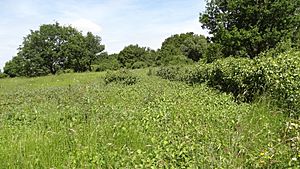Banstead Downs facts for kids
| Site of Special Scientific Interest | |
 |
|
| Area of Search | Surrey |
|---|---|
| Interest | Biological |
| Area | 126.7 hectares (313 acres) |
| Notification | 1985 |
| Location map | Magic Map |
Banstead Downs is a special natural area in Surrey, England. It covers about 126.7 hectares, which is like 313 football fields! This area is so important for nature that it's called a Site of Special Scientific Interest (SSSI). This means it's protected because of its unique plants, animals, or geology.
You can find ancient Saxon burial mounds here, which are also protected as a Scheduled monument. These mounds are like old graves from a long, long time ago. Today, Banstead Downs is a popular spot for local people to go for walks. It has open fields and wooded areas, and it even connects Belmont Village and Brighton Road to Banstead.
Contents
A Look Back: History of Banstead Downs
Banstead Downs has a long and interesting history. People have lived and used this land for thousands of years.
Ancient Discoveries and Burial Mounds
Archaeologists have found many old items on Banstead Downs. These include pottery from the Roman times and the Iron Age. They have also found axes from the Bronze Age. This shows that people were here a very long time ago!
The most famous ancient finds are the Saxon burial mounds, also called barrows. These are like big hills where people were buried. They are located at a spot called "Gally Hills." In 1972, one of these mounds was dug up. Inside, archaeologists thought they found the remains of a Saxon warrior. Other burials were also found nearby.
How the Downs Changed Over Time
Banstead Downs has always been a wide, open grassy area. It's part of the North Downs, which is a line of hills in southern England. For a long time, Banstead Downs was connected to Epsom Downs. But in the early 1900s, houses were built at Burgh Heath, separating them.
The Downs are quite close to London, less than 15 miles away. They rise up quite suddenly, making them a noticeable part of the landscape.
Sheep and Wool: A Rich Past
Long ago, Banstead Downs was famous for its sheep. The grassy fields were perfect for them to graze. The wool from these sheep was very good quality. In fact, in 1454, people in the House of Commons even asked that Banstead Down wool should not be sold for less than 100 shillings because it was so valuable!
The old inn in Banstead village, called the 'Wool Pack,' reminds us of this important wool trade. There's even a story from 1324 about a fight over 1,500 sheep on Banstead Down!
Sports and Royal Visits
Banstead Downs was once a lively place for sports and entertainment. The dry, chalky ground was great for many activities. Huge crowds would gather for horse races, foot races, wrestling, and hunting.
Royal horses were kept nearby at Belmont, where there were also training stables. Kings and queens from Nonsuch Palace often visited the Downs. The Royal Hare Warren, a place for hunting hares, was visited by at least four kings!
There are records of races happening here as early as 1625. A famous footrace took place in 1663, and a well-known prize-fight in 1669. Even important people like the Duke of Monmouth were known to ride in the horse races.
Military Gatherings
The Downs were also used for military purposes. In 1670, the Surrey Militia, a local army group, gathered here. The King, Charles II, and Prince Rupert even came to inspect the troops. There were also talks about setting up a larger army camp here in 1678.
Highwaymen on the Downs
During the 1600s and 1700s, Banstead Downs became known for highwaymen. These were robbers who would wait to attack wealthy travelers. People going to the races, visiting the popular spa town of Epsom, or traveling from London to Brighton were often targets.
In 1731, a newspaper reported about a young lady who was attacked by a highwayman. She bravely fought him off with her whip until help arrived! Another story from 1735 tells of a gentleman and his wife who were robbed of their silver watch and money by a highwayman in Potter's Lane, near the Downs.
What Makes Banstead Downs Special Today?
Banstead Downs is one of four important green areas in the region. These areas are known together as Banstead Commons. The other areas are Burgh Heath, Banstead Heath, and Park Downs.
Home to Rare Butterflies
Banstead Downs is a very important place for wildlife. It is home to a special and rare insect called the small blue butterfly. Protecting places like Banstead Downs helps these beautiful creatures survive.
Images for kids



